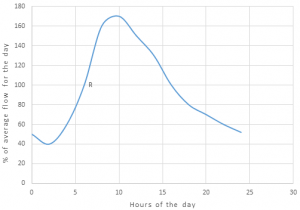This set of Environmental Engineering Multiple Choice Questions & Answers (MCQs) focuses on “Storm Water Flow”.
1. Which of the following represents the minimum flow?

Figure: Hourly variation of sewage flow
a) A
b) B
c) C
d) D
View Answer
Explanation: The figure clearly shows that the minimum flow occurs at point A and its magnitude is 50.
2. Which of the following represents the peak flow?

Figure: Hourly variation of sewage flow
a) A
b) B
c) C
d) D
View Answer
Explanation: The peak flow is the maximum flow which occurs at point B and its magnitude is 170.
3. The point R in the figure represents the ________

Figure: Hourly variation of sewage flow
a) Minimum flow
b) Maximum flow
c) Average rate of flow
d) Peak flow
View Answer
Explanation: The average rate of flow lies between the maximum and minimum flow. Here, R represents the average rate of flow which lies between point B and A.
4. At what time the peak flow takes place?

Figure: Hourly variation of sewage flow
a) 3hours
b) 7hours
c) 10hours
d) 14hours
View Answer
Explanation: The peak flow takes place at point B and the corresponding time is 10 hours.
5. In India, the maximum sewage flow occurs normally in which month?
a) July
b) January
c) February
d) December
View Answer
Explanation: In India, the maximum sewage flow occurs during June and July as maximum utilization of water takes place.
6. The minimum sewage flow occurs normally in which month in India?
a) March
b) January
c) August
d) July
View Answer
Explanation: The minimum sewage flow in India is assumed to occur during December or January.
7. The peaking factor is defined by __________
a) Peak flow * Average flow
b) Peak flow – Average flow
c) Peak flow + Average flow
d) Peak flow / Average flow
View Answer
Explanation: The peaking factor is the ratio of Peak flow to the Average flow and it is highest for domestic sewer as they receive the flow directly from the source.
8. Which of the following has a maximum peaking factor?
a) Domestic sewer
b) Branch sewer
c) Main sewer
d) Trunk sewer
View Answer
Explanation: The domestic sewer has the maximum peaking factor of 6 while Branch sewer, Main sewer and Truck sewer has a peaking factor of 3, 2.5 and 2 respectively.
9. The Lateral sewer has a peaking factor of ____________
a) 1
b) 2
c) 3
d) 4
View Answer
Explanation: The peaking factor of lateral sewer lies between 4 to 6 which is greater than Branch sewer, Main sewer and Truck sewer.
10. The population of the city is 30,000. What is the peaking factor?
a) 1
b) 2
c) 2.25
d) 2.5
View Answer
Explanation: When the population of the city is between 20,000 to 50,000, the peaking factor is 2.5.
11. The peaking factor is directly proportional to the population of the city.
a) True
b) False
View Answer
Explanation: When the population of the city is less than 20,000, the peaking factor is 3.5 and when the population of the city is above 7,50,000, the peaking factor is 2. So, the peaking factor varies inversely with the population.
12. _________ flow persists for various time duration.
a) Minimum sewage
b) Maximum sewage
c) Sustained
d) Average sewage
View Answer
Explanation: Sustained flow persists for various time duration. They are important in sewage design when they are higher or lower than than average flow.
13. The wet weather flow is also known by ______
a) Minimum sewage flow
b) Maximum sewage flow
c) Storm water flow
d) Average rate of flow
View Answer
Explanation: The wet weather is also known by the storm water flow and is commonly abbreviated as W.W.F.
14. Consider the following statement.
The storm water flow depends on
i. Catchment area
ii. Ground slope
iii. Quality of water
vi. Rainfall duration
Which of the following is correct?
a) i, ii
b) i, ii, iii
c) i, ii, iv
d) i, iv
View Answer
Explanation: The storm water flow depends on the catchment area, ground slope, permeability of ground, extent of vegetative growth, rainfall intensity and duration, condition of the ground and climatic conditions.
Sanfoundry Global Education & Learning Series – Environmental Engineering.
To practice all areas of Environmental Engineering, here is complete set of 1000+ Multiple Choice Questions and Answers.
If you find a mistake in question / option / answer, kindly take a screenshot and email to [email protected]
- Check Environmental Engineering Books
- Practice Mining Engineering MCQs
- Check Mining Engineering Books
- Apply for 1st Year Engineering Internship
